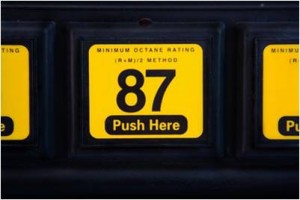 When you go to the gas station and there are typically three different grades of gas. These gases are different because of their octane rating.
When you go to the gas station and there are typically three different grades of gas. These gases are different because of their octane rating.
What is octane?
Octane is gasoline rating that indicates how much the fuel can be compressed before it spontaneously ignites. It is not a energy density rating, which means that a higher octane fuel will not let make your fuel last longer than the minimum octane rated for your engine.
The internal combustion engine that is in all of our cars has piston and cylinder, the piston moves up the cylinder and compresses the gasoline and air and is then ignited by a spark plug. If the gas ignites due to compression rather than by the spark plug, this causes a condition known as knocking. Knocking can damage an engine, so it is not something you want to have happening.
 The compression ratio of your engine, the amount of compression your piston makes each cycle, determines the minimum octane rating your engine requires. One way to increase the horsepower of an engine of a given displacement is to increase its compression ratio. So a high-performance engine, such as Audi, Volvo, etc, will have a higher compression ratio and requires a higher octane fuel. The advantage of a high compression ratio is that it gives your engine a higher horsepower rating for a given engine weight — that is what makes the engine “high performance.” The disadvantage is that the gasoline for your engine costs more. I drive an Audi that has a high compression engine that is also has a turbo, the engine is requires 91 octane. I also have a Toyota 4runner that has a ‘normal’ engine and only requires 85 octane.
The compression ratio of your engine, the amount of compression your piston makes each cycle, determines the minimum octane rating your engine requires. One way to increase the horsepower of an engine of a given displacement is to increase its compression ratio. So a high-performance engine, such as Audi, Volvo, etc, will have a higher compression ratio and requires a higher octane fuel. The advantage of a high compression ratio is that it gives your engine a higher horsepower rating for a given engine weight — that is what makes the engine “high performance.” The disadvantage is that the gasoline for your engine costs more. I drive an Audi that has a high compression engine that is also has a turbo, the engine is requires 91 octane. I also have a Toyota 4runner that has a ‘normal’ engine and only requires 85 octane.
The name “octane” comes from the following fact: When you take refine crude oil and break it down, you end up getting hydrocarbon chains of different lengths. These different chain lengths can then be separated from each other and mixed to form different fuels. For example, propane, methane, and butane are all hydrocarbons. Methane has a single carbon atom. Propane has three carbon atoms chained together. Butane has four carbon atoms chained together. Pentane has five, hexane has six, heptane has seven and octane has eight carbons chained together.
Next time you pull up at the pump, use the fuel that meets your octane requirement. You can find your octane rating on the inside of your gas door or your user manual. Using a fuel that has a higher octane than needed is just a waste of money.
Leave a Reply